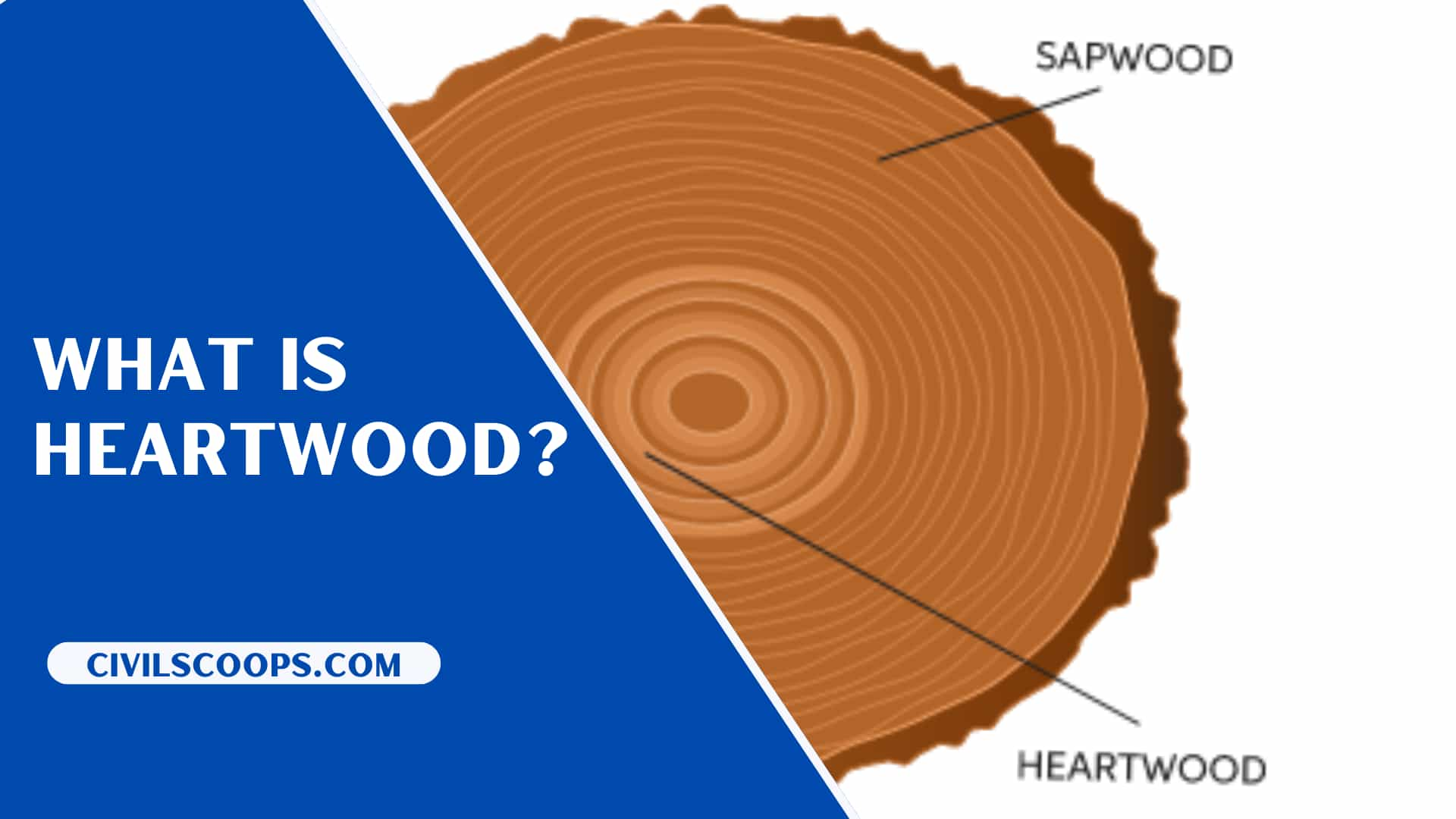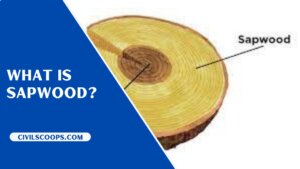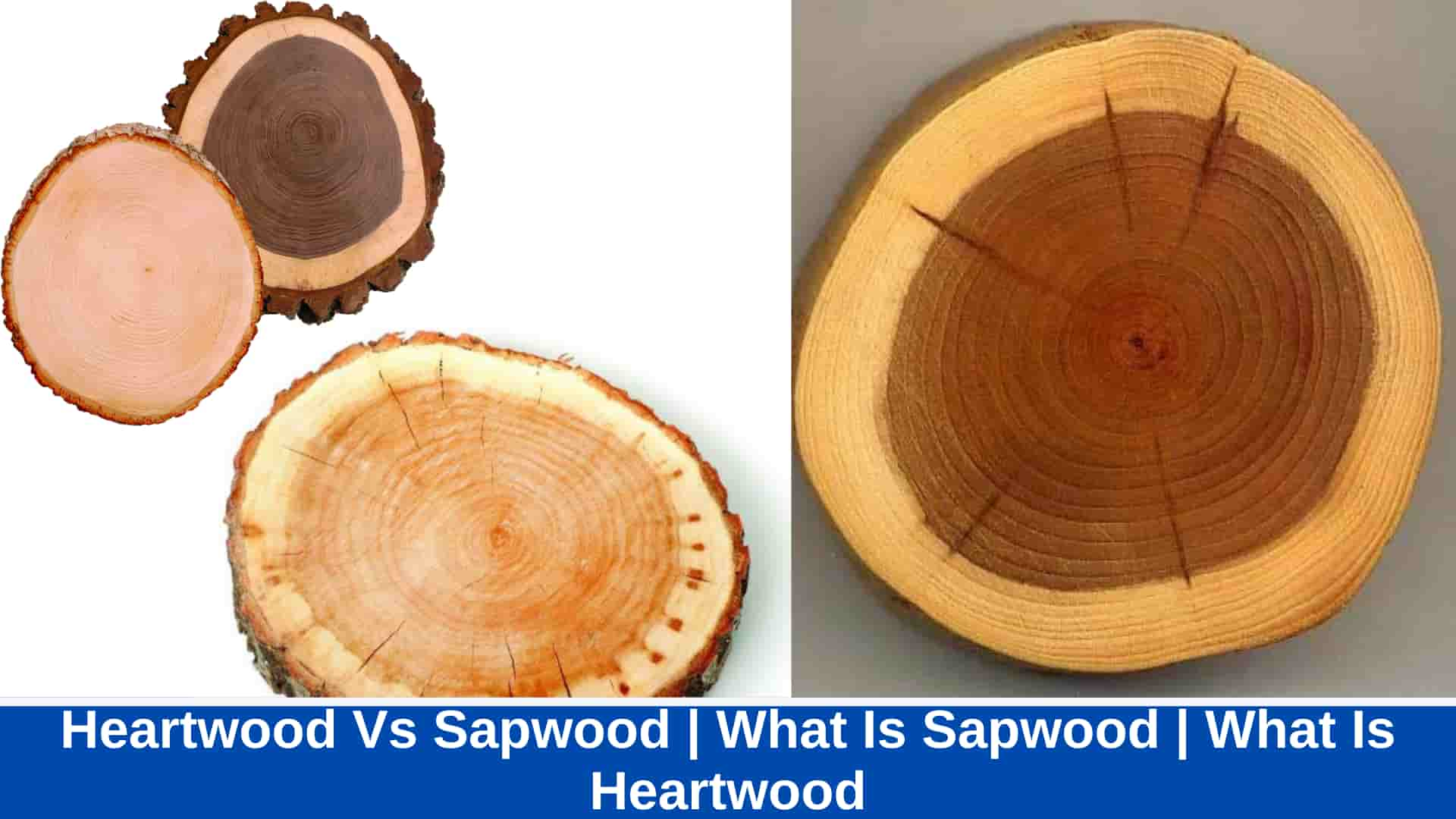Difference Between Heartwood and Sapwood | What Is Sapwood | What Is Heartwood
Table of Contents
Difference Between Heartwood and Sapwood
The main difference between the heartwood and the sapwood is that the heartwood is deadwood, interior, while the sapwood is the outermost portion of a wood that is alive. Hardwood vs sapwood
In addition, the heartwood occupies a large part of the transversal area of the wood, while the sapwood occupies a small area. In addition, the sapwood is generally light in color when compared to the heartwood.
Heartwood and sapwood are the two areas in a cross-section of a woody stem. Both types of wood play a critical role in a tree.
What Is Heartwood?

Heartwood or durame is the inner portion of the woody stem, containing clogged secondary xylem. Heartwood formation is genetically programmed. With growth, the stem increases its diameter, forming new xylem and phloem. Therefore, the most centered and ancient xylem becomes useless.
Then, that part of the xylem becomes a part of an essential function for the tree. For this, the cells in the center of the trunk die and chemical compounds accumulate in them. Some of these compounds are resins, terpenes, and phenols.
So it gives the heart a dark color. In addition, this offers resistance to decomposition and the ability to prevent insects and fungal infections. In addition, this allows for functional change. Therefore, the main function of the heartwood is to provide structural support to the tree.
What Is Sapwood?

Alburnum or laburnum is the initial wood form of any tree. It occurs from a thin layer of cells under the bark, called the vascular cambium, which produces wood cells for the interior and bark cells for the exterior.
Therefore, sapwood always contains newly formed cells that are alive. In addition, as these cells do not contain chemical compounds deposited as resins, the sapwood is lighter in color and has a soft texture.
However, it is more prone to attacks by fungi and insects. The main function of sapwood is to transport water and nutrients throughout the plant. Collectively, water and nutrients are known as sap. In addition, the sapwood cells also provide structural support to the tree.
Also Read: All Abot Parts of Stairs | Stairs Parts Names & Details | Parts of Stairs Parts Names & Details
Heartwood Vs Sapwood
1. Definition of Heartwood and Sapwood
The heartwood refers to the dense internal part of a tree trunk, producing the hardest wood, while the sapwood refers to the soft outer layers of the newly formed wood between the heartwood and the bark, containing the functioning vascular tissue.
Thus, this is the main difference between heartwood and sapwood.
2. Heartwood and Sapwood: Also Called
In addition, another name for heartwood is duramen and that of sapwood is sapwood.
3. Heartwood and Sapwood: Occurrence
Another difference between the heartwood and the sapwood is that the heartwood occurs in the center of the stem, while the sapwood occurs in the peripheral region.
4. Heartwood and Sapwood: Cells
In addition, the heartwood cells are relatively old, and most of them are dead, while the sapwood cells are young and most of them are alive. In addition, the heartwood contains densely arranged cells, while the sapwood cells are poorly arranged. So this is also a difference between heartwood and sapwood.
5. Heartwood and Sapwood: Color
In addition, color is another difference between heartwood and sapwood. The heartwood is usually dark in color, while the sapwood is light in color.
6. Heartwood and Sapwood: Weight
In addition, the heartwood is heavier than sapwood.
7. Heartwood and Sapwood: Hard & Soft
In addition, the heartwood is hard while the sapwood is soft.
8. Heartwood and Sapwood: Composition
Another difference between heartwood and sapwood is its composition. The heartwood contains more lignin, while the sapwood contains more cellulose than the other.
9. Heartwood and Sapwood: Conductivity
Also, the heartwood serves as an insulator, while the sapwood serves as a conductor.
10. Heartwood and Sapwood: Occupation
Its function is also a big difference between heartwood and sapwood. The heartwood is responsible for providing structural support to the tree. On the other hand, sapwood transports water and nutrients, providing structural support.
11. Heartwood and Sapwood: Durability
Also, the heartwood is durable, while the sapwood is not durable. Also, the heartwood is resistant to insects and fungal infections, while the sapwood is more prone to fungal infections and insect attacks.
Therefore, the heartwood is suitable for furniture, but not the sapwood.
12. Heartwood and Sapwood: Fungal Attack
Hardwood: Wood is resistant to insect and fungal attacks.
Softwood: Wood is susceptible to insect and fungal attacks.
Main Difference Between Heartwood and Sapwood
- Sapwood = Alive, active and functional
- Heartwood = Dead, inactive and non-functional.
Explanation
- Some other important differences for conceptual clarity:
- The heartwood can be seen mainly on older stems. While the sapwood comprises the younger layers of wood. It means that it is the first wood in the trees.
- The sapwood is the softest external part of the woody stem. While the heartwood is a hard central part or internal part of the sapwood.
- The heartwood deposited with certain compounds, such as gums, tannins, oils, resins, is darker in color. On the other hand, sapwood without deposition of such materials has lighter colors.
- The sapwood is driving the wood, as it drives the sap (fluid containing dissolved minerals and water) between the roots and the crown of the tree. Also, keep some of them on rainy days. The heartwood is not conducive due to blocked intercellular spaces.
- The heartwood has negligible intercellular spaces in relation to the cells, which are blocked mainly with dead material, that is, lignin. The sapwood has enough intercellular spaces for its cells to help it conduct materials.
- The sapwood, soft and without deposition, is susceptible to decomposition and attack by insects. While Heartwood is very resistant to attack and decomposition of insects.
- Sapwood provides nutrients, water, and minerals in the form of sap to various parts of the plant. The heartwood supports the plant.
Heartwood Va Sapwood: Conclusion
The heartwood is the innermost and hardest part of a woody stem, which contains mainly obstructed secondary xylem. Due to its durability, the heartwood is better for furniture. On the other hand, the sapwood is the most external and soft part of the woody stem, consisting of functional secondary xylem.
The main function of the sapwood is to transport sap. However, heartwood mainly provides structural support. Therefore, the main difference between heartwood and sapwood is structure and function.
Sapwood and Heartwood PDF: Click Here
[su_box title=”FAQ” style=”default” box_color=”#333333″ title_color=”#FFFFFF” radius=”3″ class=”” id=””]
Heartwood Vs Sapwood
Sapwood is the outer light-colored portion of a tree trunk through which the water passes from the roots to the leaves, and in which excess food is often stored. Heartwood is the central core of the trunk. In most woods the heartwood can be distinguished from the sapwood by its darker color.
Walnut Heartwood Vs Sapwood
The simple answer, in most cases, is heartwood. It’s denser, stronger, and dryer than sapwood. Also, it’s usually the heartwood that has the characteristic color of the given wood species, such as the rich brown of walnut or the reddish hues of cherry.
Maple Heartwood Vs Sapwood
Sapwood is the living, outermost portion of a woody stem or branch, while heartwood is the dead, inner wood, which often comprises the majority of a stem’s cross-section. You can usually distinguish sapwood from heartwood by its lighter color.
Function of Heartwood and Sapwood
Sapwood performs the physiological activities, such as conduction of water and nutrients, storage of food, etc. The function of heartwood is no longer of conduction, it gives only mechanical support to the stem. The heartwood part of a tree is also far more susceptible to fungus than the centre of the trunk.
What Is Heartwood Used For?
Heartwood is formed from old, “retired” sapwood and becomes the strong spine of the tree. Heartwood is preferred for woodworking, as it is far less susceptible to fungus and contains much less moisture than sapwood, which means it will shrink less when it dries.
What Is Sapwood Used For?
The outer, lighter-colored wood is the sapwood. This is the “working” part of the tree, since water and sap flow through the sapwood much like blood through your arteries, veins, and capillaries. While this part of the trunk is vital to the tree when it is living, it doesn’t make for very good stock for woodworking.
Difference Between Heartwood and Sapwood Brainly
Heartwood occurs in the central portion of an old stem. Sapwood occurs in the peripheral (outer) portion of an old stem.
Color of Sapwood and Heartwood
Sapwood is light-colored creamy white to light yellowish in color. The heartwood ranges in color from light to dark brown.
[/su_box]
[su_note note_color=”#F2F2F2 ” text_color=”#333333″ radius=”3″ class=”” id=””]
Like this post? Share it with your friends!
Suggested Read –
- Types of Wood
- Information About Contractor
- What Is Traffic Rotaries? | Rotary Intersection | What Is Rotary Island? | Advantages & Disadvantages of Traffic Rotary
- What Is Tie Beam? | Tie Beam Details | Ties in Column | Tie Beam Design | Concrete Tie Beam | Tie Beam Reinforcement Details
- Types of Curing | Concrete Curing Time | How to Cure a New Concrete Slab | What Is Curing of Concrete | How Long Does Concrete Take to Dry | How Long Does It Take for Cement to Dry
[/su_note]
Originally posted 2022-07-27 13:16:03.

